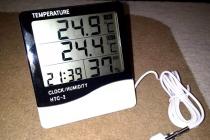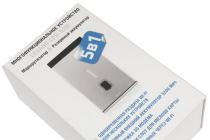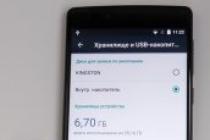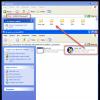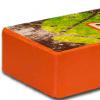Lexand LPB-52W is a multifunctional device that combines the properties of a router and a large-capacity backup battery that lasts all day. Although these are only two of the strengths of our today's experimental subject, a closer look reveals much more of them. Such a router can distribute the Internet to many devices from any local network or via a 3G modem, be a wireless USB host and be used as a full-fledged power bank.
In general, Lexand is well known in our market, which is largely determined by the presence of many interesting automotive products. For example, DVRs and navigators of this brand have long been popular with advanced motorists. But today we will not talk about them, but we will test a somewhat non-standard and unusual device that will come in handy in the car, help on the road and will not even be superfluous at home.
Contents of delivery

Lexand LPB-52W is sold in a small cardboard box, inside which, in addition to the router itself, you can find a couple of necessary accessories.

The standard package includes a USB cable for charging the battery, a convenient C-shaped USB adapter, a cloth case and papers (user manual, warranty card).

In general, the necessary set of little things is present, but if the manufacturer pays such considerable attention to automotive topics, then it would not be out of place to put auto-charging in the box.
Case design and features


The device is made in a fairly convenient form factor of a flat mobile device, so this is best reflected in the usability. The LPB-52W does not take up much space, and it is not at all difficult to carry it with you.

There are a decent number of connectors, switches and indicators on the case, so this point is worth dwelling on in more detail.

Let's start with the fact that the battery in this case is made removable. This is convenient, because in a few years, when it starts to “age”, it will be easy to make a replacement. To access the battery, just slide the back panel. In our case, a lithium-polymer battery with a capacity of 5200 mAh is used. For example, this is enough to recharge a standard smartphone battery twice. By the way, Lexand also has an even more capacious LPB-78W model at 7800 mAh.

If you remove the battery, then under it you will find a microSD card slot and a sticker with the main factory parameters. The hardwired IP address, login and password for entering the administration panel and the MAC address are specified here. In general, after inserting a card, you can never come back here.

On one of the ends of the device there is a power-on slider, which is rather problematic to move accidentally, which is also very good.

After activating it, the Lexand LPB-52W starts to boot, and a row of LEDs lights up on top. With their help, you can judge the status of the device, for example, Wi-Fi activity, Ethernet status, and the state of charge of the battery. The latter is indicated quite approximately, but it’s still much more convenient to know if the charge is close to 80% or 20% than not to know anything.

An Ethernet connector for connecting to a local network and two USBs are mounted on the front end of the device. One port is used for using 3G modems and drives with the appropriate interface, the second is for charging mobile devices.

By the way, here you can very successfully use the C-shaped adapter from the delivery kit, which allows you to make the Lexand LPB-52W bundle and the modem, for example, more compact.

The second sliding-type mechanical switch is used to quickly change the operating mode between 3G and DHCP. To do this, you do not have to go to the administration panel, since one click is enough.

To charge the device, a microUSB connector is used, and next to it there is a reset button to factory settings. To do this, it must be held for more than 8 seconds. If you press it for 2-4 seconds, then you will disable the Ethernet port. For example, in a car, this function is not needed, and you can save 20% of the battery charge.
Setup and use
We can say that the Lexand LPB-52W is replete with numerous settings, many of which will be completely incomprehensible to most users, however, in order to use the main functions normally, just a couple of clicks are enough. To do this, you need to go to the administrator interface at the local address 192.168.100.1 through a browser. Unfortunately, the Russian language is not provided here, only English. What is somewhat strange - Lexand is a Russian company, although this can be fixed in more recent firmware.


Initially, we select the operating mode of the device and make the basic settings. The most relevant, of course, is the use of a 3G modem. By the way, Lexand claims support for many of our popular ZTE and Huawei modems. For example, LPB-52W is compatible with Huawei E303 sold by all three operators: velcom, MTS and life:). It also supports Huawei E353 available from velcom and MTS. Probably, there will be no problems with Huawei E355, which is sold by life:). Yes, and ZTE MF668 from life :), apparently, will be able to work with a router.
To connect to the Internet, you will need to set an access point (APN), login and password. All this data is issued by the mobile operator. After that, the router automatically connects and starts distributing the Internet via Wi-Fi. There are no restrictions on work, and the speed of operations will depend on the capabilities of the selected tariff plan.


In the default mode, the connection is completely open, and anyone can access it. If this seems redundant to you, the installation of any popular encryption method and password is available. By the way, you can also set the speed of Wi-Fi itself, as the fast 802.11n standard is supported. And in advanced settings, even the transmitter power is set. If you do not need a large coverage, then there is another loophole to save battery power.

The rest of the router settings are quite typical for this kind of devices. For example, you can enable a filter by MAC addresses, configure DHCP to distribute IP addresses, install the NAS protocol, etc. But again, for most users, this is overkill. The router works quite normally already in the default mode, for example, in order to distribute the Internet from a local point using Ethernet, it is enough to make a wired connection. The function is certainly interesting, but in the light of current realities, it looks secondary.






Statistics for monitoring 3G connections allows you to track the amount of traffic used, which can also be useful.



Separately, it is worth considering working with drives, since the Lexand LPB-52W provides the ability to wirelessly access data recorded on them. In 3G mode, the microSD card installed inside works. If you move the mechanical slider to the DHCP position, then the device connected to the USB port starts working. There is no difference in their functioning, since the data will be available at 192.168.100.1:6060. There are no particular complaints here, but still we encountered one unpleasant moment when the router did not recognize one ordinary 2 GB Kingston flash drive. There were no problems with other carriers.

If we talk about the autonomy of the device, then the situation turned out as follows. When distributing the Internet from a local ADSL modem, one charge was enough for about 7 hours of work with moderate surfing. Taking into account the fact that in such a mode the greatest amount of energy is spent, this time can be considered the minimum possible. In general, autonomy is good, because even with continuous use it will last for a whole working day.
Conclusion
In general, we see the Lexand LPB-52W as a rather interesting device with its own scope. Of course, the most relevant such device will be on the road. Firstly, you can organize fast distribution of the Internet via Wi-Fi from one 3G modem. It turns out very convenient for a company of users. Secondly, the same can be done with Ethernet. Thirdly, a wireless NAS will literally work on the knee. Finally, fourthly, you can simply recharge your smartphone.
Price
Lexand LPB-52W can be bought for $90, which is quite a lot of money. It is clear that the router itself is much cheaper, and the final price is due to the functions in the form of a battery and advanced features.

TP Link TL-MR3040
However, competitors are on the alert, and for $40 you can buy a TP-Link TL-MR3040 mobile router. It does not have a USB host, the battery has a capacity of 2000 mAh versus 5200 mAh, but the difference in price is noticeable, plus, there is support for current 4G modems.
Pros:
- compact body;
- capacious and removable battery;
- work in NAS mode (distribution of data via Wi-Fi and Ethernet from a microSD card);
- distribution of the Internet from a 3G modem and an ADSL modem.
Minuses:
- interface in English in our firmware version;
- may not recognize some flash memory cards;
- high price.
A pocket Wi-Fi router is a portable device that provides reception of the Internet network of cellular operators. Today, the de facto dominant technology is LTE. Operators are trying to master the Advanced option. Formally, the fourth generation is distinguished by one speed. In reality, 3G infrastructure upgrades cost money.
A brief overview will teach those who want to use mobile access to work everywhere. Take the trouble to charge the battery and let's get started!
Peculiarities
The traditional router is too big for the pocket. The rectangular body is bulky, rough. The appearance of the compact modem is much softer. The portable version is equipped with rounded shapes, the case is durable, smooth.
Operating principle
A fixed router receives broadcasts via an Ethernet cable. The mobile version is equipped with a SIM card from a mobile operator. Allows motorists to watch movies, play games, surf sites. Hypothetically, the speed is inferior to the wired network. The theoretical maximum is 100 - 150 Mbps. The real numbers are below.
Sometimes we see a traditional label indicating basic information:
- IP address of the admin panel.
- Login: Password.
- Model related information.
- Serial number.
Ports
The point distributes the network to gadgets, laptops. Wired ports are limited in number or not available at all. Think about updating the firmware - remember the annoying fact. The microUSB port serves the purpose of recharging the battery. The interface of the admin panel is, of course, compatible with the vast majority of operating systems. Use browsers.
The lithium battery needs to be recharged periodically. The kit is supplemented with an AC adapter 220 V. Parallel operation, recharging are possible.

Buttons, indication
Rollback to factory settings is done by pressing a single Reset button. In addition, available:
- Power key.
- LED activity indicator.
- Battery level.
- Network information (SSID).
Compensating for the modest size of the case, the LED indication is extremely complex. Optionally present up to a dozen colors:
- Flashing white - the battery is charged, the firmware is fresh. Used by the over-the-air software update policy.
- Flashing red - no SIM card, or an error has occurred.
- There is no color - the energy is over, the device is turned off.
- Yellow - charging, standby.
- Green - gradation according to the mode. Blinking - LTE is transmitting data. Steady—Wireless communication established.
- Lilac - speed limit (LTE protocol is not available). 3G technologies are used.
A sophisticated mnemonic system complements the LED color indication. Signal strength, remaining battery charge, number of connected subscribers, roaming are displayed.
Generation
Operators vied with each other to call the equipment the fourth generation. In reality, the developer puts forward the following bitrate requirements:
- Stationary object - 1 Gbps.
- Transport (airplanes, trains) - 100 Mbps.

The moving antenna consistently loses the lion's share of the packets, explaining the softer requirements. Providers jaws grabbed the figure of 100 Mbps, considering the beginning of the fourth generation. Western operators take a compromise - 300 Mbps. Readers guessed: the compliance of this technique with the 4G standard is doubtful. Make your choice based on the obvious.
Real iron, issuing gigabit Internet, is still a rarity. Foreign subscribers rarely need high-speed traffic. There is no demand, explaining the scarcity of supply. An example of proactive marketing was given by Western companies:
- MiFi 4510L is a fourth-generation LTE mobile hotspot…
The epithets clearly contradict each other. LTE fits the definition of maximum 3G+. Managers use a little-known fact: initially, the developers of the standard recognized LTE as the fourth generation. Later, the point of view was revised, the boastful statements of marketers remained. The speed of the MiFi 5410L model barely reaches ... 100 Mbps. A real failure.

Protocol
Typical models support IEEE 802.11b, g, n. The remaining options are called exotic.
Example
Model MiFi 620L provides support for 15 XLTE devices, maintains autonomous performance for 20 hours. Advanced technology complemented by powerful control features.
The 620L Wireless Router supports USB cable connection. Allows you to choose the best update method. The LED indicator system is formed by a fixed-purpose LED group. Color coding displays typical equipment states (see above).
Supports for phone access:
- CDMA Rev A, 0, 1XRTT.
- UMTS/HSPA.
- GPRS/EDGE.
This article will help those people who have heard about the existence of portable Wi-Fi routers, but do not fully understand what it is and what this device is intended for. Suitable for those who have already decided to purchase a portable Wi-Fi gadget, but do not know how to choose the right one among the many models on our market.
Let's start with what kind of device it is and about its areas of application.
A portable Wi-Fi router is a mobile device that receives a signal from the operator's network and re-eats the Internet over a Wi-Fi network. You can connect to it any device that can receive the Internet via a Wi-Fi network (phones, smartphones, tablets, laptops, desktop computers, TVs, IPTV players). Moreover, you can connect several devices at the same time. The portable Wi-Fi router operates in the 802.11 b/g/n standard (up to 150 Mbps). The range of the average model is 10-20 meters.
You can use portable routers in cases where it is impossible to access conventional cable Internet and for trips to places with limited access to the Internet (to nature, fishing, to the country), going to a cafe, library, school. It is convenient to take with you on business trips, take with you for presentations. And most importantly, with such a device you can use the Internet even in the absence of electricity in the network.
Each device of this type has its advantages and disadvantages.
Advantages:
- Suitable for Wi-Fi connection with almost all devices.
- Own battery, no need to connect additional power cords through other devices.
- Usually the tariff for the Internet is cheaper than on mobile phones, smartphones.
- Stable good Wi-Fi signal.
- The ability to use the router both at home and outside the city.
Flaws:
- You will have to carry another gadget in your pocket or purse.
- There is no auto-off mode (it's easy to forget to turn off the device after work).
- Short battery life of 2 to 5 hours, even for models with large batteries no more than 12 hours.
- Some models may work unstably in rooms, car interiors with high temperatures and high humidity. But this is a problem with many electronic gadgets.
Now you can move on to the purchase itself. How to choose the right device for you, because there are a lot of devices in our stores and websites that allow you to receive the Internet that is so necessary for us without wires. When choosing a portable Wi-Fi router, there are many factors to consider.
- Decide on the choice of provider (operator providing services). An important factor is the coverage of a particular mobile operator.
- The presence of a connector for connecting an antenna (to increase the signal strength of a portable device).
- Operating conditions, whether the device will be stationary or constantly moving with you. An important factor here is the dimensions, weight and autonomy (battery capacity) of a portable Wi-Fi router.
- Familiarize yourself with the operating instructions, technical characteristics and operating conditions of the device.
When buying in stores or communication salons, a sales manager will surely help you. And when buying in online stores, it is better to use the provided filters that will facilitate your choice. Or contact the online manager.
Today, modern technologies are becoming more and more firmly established in our lives and devices for mobile communication are increasingly being used. The presence of portable equipment that allows you to connect to the Internet in any conditions has become commonplace. You can go online outside the city, in transport, distribute Wi-Fi in the country. But this requires a portable Wi-Fi router.
What kind of device and why is it needed?
A router or it is also called a router is a wireless type device for connecting wireless access (wi-fi) to the Internet. It is designed to solve many problems, but the main one can be called the organization of a local network for accessing Internet resources. Some models can support not only signal transmission at different speeds, but also a wired type interface.

This router is designed to establish a connection with the global network, which makes it possible to effectively distribute Internet traffic, and you can also use alternative paths between network nodes. If you have an Ethernet cable (don't forget if you're setting it up yourself), plug in a portable one and set up wireless access for multiple devices. And in nature or in the country, use a device with a SIM card and get communication from a mobile operator.
How to choose
Before you buy a portable Wi-Fi router, you need to decide on the parameters that will allow you to purchase the model you need. The main criteria include:
- Type of WAN ports. This indicator should correspond to your home Internet. If it is incorrect, then the device simply will not work. Most often, the equipment works on the basis of a SIM card from a mobile operator. An example is the portable Wi-Fi routers Beeline, Megafon or MTS.
- Signal speed is one of the important characteristics of a router. If you buy a portable Wi-Fi router, the price of which does not exceed 1000 rubles, then the speed will be somewhere in the range up to 150 Mbps. This option is suitable when used on 1-2 devices. At a cost of over 1500 rubles, you can count on speeds over 300 Mbps.
- The frequency of the routers. Here are two options from 2.4 GHz to 5 GHz. Since today routers are present in almost every apartment, the 2.4 GHz frequency can be overloaded and the signal transmission speed may suffer from this. Using a frequency of 5 GHz allows you to get a free frequency without interference. It is also possible to purchase a device that can support several frequencies at once.
Rating portable wi-fi routers
Among the models that, according to Yandex Market reviews, are very popular can be noted.

